skip to main |
skip to sidebar
(This article was originally featured in "St. Louis Game Time," Vol. 4 No. 7, October 31, 2008 in "Tomorrow's Blues with Brian Weidler")In the last edition of "Tomorrow's Blues," we caught up with the more high-profile members of the Blues' stable of college prospects. Tonight, we'll take a look at the guys who don't stand out from the crowd quite as much.
There is an entire forward line, plus one, in tonight's crop, plus a converted forward now playing defense. All of the forwards have what the scouts like to call "NHL size," and at least two of them are possible power forwards in the making.
Matthew McCollem (LW, shoots L, 6'1, 205; Blues' 6th pick, 154th overall, in 2006): Something of a dark horse among Blues' prospects, McCollem is a potential home-grown Keith Tkachuk... he has the size, he has the Boston background, and he has the nose for the net.
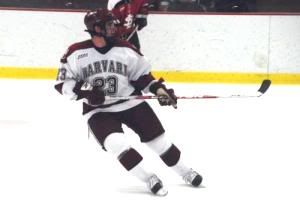 A former captain and scoring leader at one of the most prestigious prep programs in the Boston area (Belmont Hill), McCollem's career at Harvard did not get off to a great start last year (0 G, 3 A, minus-7 in his first 18 games). Once February rolled around, however, McCollem heated up as fast as the weather outside cooled down.
A former captain and scoring leader at one of the most prestigious prep programs in the Boston area (Belmont Hill), McCollem's career at Harvard did not get off to a great start last year (0 G, 3 A, minus-7 in his first 18 games). Once February rolled around, however, McCollem heated up as fast as the weather outside cooled down.
"He got off to a slow start [last year]," Crimson coach and former NHLer Ted Donato said in the US College Hockey Online.com Harvard season preview, "but in the last third or half of the season he was superb. He’s got the physical tools that make him very difficult to stop when he’s on his game."
"Superb" just about covers it when describing McCollem's first spring as a collegian. In his last 13 games, the Somerville, MA native racked up five goals and 11 points, a plus-8 mark, and six minutes in penalty time, leading Harvard to the NCAA East Regional Final before falling to Princeton, one game shy of a Frozen Four appearance.
For the 2007-08 season, McCollem's totals were a very respectable 5-9-14 in 31 games, with a plus-1 and 28 minutes in the sin bin. The Crimson are counting heavily on McCollem to be one of their leaders on offense when they kick off the 2008-09 season on Oct. 31 vs. Lee Stempniak's alma mater, Dartmouth.
Andrew Sackrison (C/W, shoots L, 6'1, 200; Blues' 5th pick, 124th overall, in 2006): The Blues have found a pretty rich vein of talent at Minnesota State - Mankato in recent years, bringing draftee David Backes and free agent Steve Wagner out of school early and into the organization in recent years. The club hopes to continue this tradition with St. Louis Park, MN native Andrew Sackrison.
Another potential power forward for the Blues, Sackrison has bulked up from his draft weight of 178 pounds, and his no-frills game of finishing his checks and working hard on the penalty kill translates well to the NHL style.
McKeens Hockey Prospects website notes that Sackrison is a player that doesn't hesitate to drive to the front of the net, and his excellent balance and strength make him tough to move once he gets there. McKeens also notes that Sackrison is not an elite scorer or playmaker, but is a better-than-average passer with good on-ice vision, and that he "pursues the puck adequately where his fine top gear is commanding in the open ice."
As a freshman at MSU last year, Sackrison rang up six goals and 20 points in 36 games. In the USCHO.com Minnesota State 2008-09 preview, Mavericks coach Troy Jutting calls Sackrison, along with juniors Kael Mouillerat and Geoff Irwin, a player that is "ready to step up from the 20-point plateau and into that 30-point range. And, if you can get five, six kids in that range, I think you can be successful."
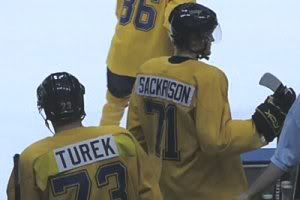 This year, Sackrison has been playing on a line with Irwin and Jason Wiley, and Sackrison assisted on goals by both Wiley and Irwin as the Mavericks split a series with North Dakota last weekend.
This year, Sackrison has been playing on a line with Irwin and Jason Wiley, and Sackrison assisted on goals by both Wiley and Irwin as the Mavericks split a series with North Dakota last weekend.
Trevor Nill (C, shoots R, 6'2, 185; Blues' 7th pick, 190th overall, in 2007) and Ryan Turek (D, shoots R, 6'0, 185; Blues' 4th pick, 94th overall, in 2006): Both Turek, a junior, and Nill, an incoming freshman, skate for Rick Conley's Michigan State Spartans, and each has a single assist in early-season play. Turek was a member of the 2006-07 national championship team, but did not appear in the final game and only played in one game on Scottrade Center ice during the Frozen Four that year.
Turek was a swingman in junior hockey, playing both defense and center with Omaha of the USHL in his draft year, but has since been converted into a full-time defenseman at Michigan State. McKeens Hockey Prospects website notes that the switch to defense "suit(s) his game better. (Turek) displays good range, as he utilizes his strong stride well to jump and join the offensive attack as well as to cover up a lot of ice while defending." McKeens also notes that the Northville, MI native is "fairly strong with a big frame that he uses well to be tough in front of his crease, neutralize his man along the wall, and to stand up his man at the blueline."
Never an elite scorer even in junior, Turek's next collegiate goal will be his first. He has, however, managed 8 career assists in 71 games to date, and has recovered from a minus-9 mark as a freshman to be a valuable member of the Spartan blueline.
Nill, son of Red Wings' executive and former Blue Jim Nill, developed in and was drafted out of the Detroit Compuware junior program before heading west for a season with the Penticton Panthers of the British Columbia Junior League last year, where he was 5-6-11 with 16 PIM in 53 games.
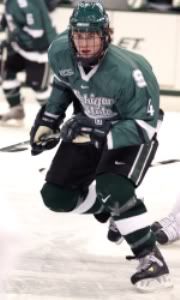 McKeens notes that Nill was "not expected to provide a lot of offense in the early going (at MSU this year), however (he) provides welcome size down the middle and plays a mature game on the defensive side of the puck." His defensive skills include an ability to tie up his man when taking faceoffs, and a regular shift on the penalty kill.
McKeens notes that Nill was "not expected to provide a lot of offense in the early going (at MSU this year), however (he) provides welcome size down the middle and plays a mature game on the defensive side of the puck." His defensive skills include an ability to tie up his man when taking faceoffs, and a regular shift on the penalty kill.
Nill "probably should get a bit more out of his 6-foot-2, 185-pound frame than he currently does," McKeens also notes, and "seems to lack the elite vision with the puck that would allow him to be able to distribute the puck better."
Travis Erstad (C, shoots R, 6'4, 205; Blues' 8th pick, 100th overall, in 2007): Originally scheduled to attend UW-Madison this season, Erstad decided at the 11th hour to return home to Stevens Point and opted to enroll at the hometown branch of the UW system instead. The decision to forego a Division I career to play in Division III doesn't bode well for Erstad's pro future, as only a handful of players have ever been drafted out of a Division III school, and no notable current NHL players have attended one.
UW-SP has played one game so far this season, a 10-0 rout of Northland College. Erstad started the game for the pointers, but managed only one assist out of the 14 awarded on the Pointer goals. Last year with Lincoln of the USHL, Erstad racked up 9-10-19 totals and 104 PIM in 52 games.
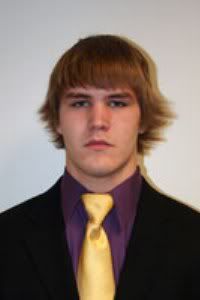 At 6'4, 205, Erstad has the size and the skill set to make an impact no matter what level he plays, but there's some question about the heart, and the willingness to pay the price for a high-level career
At 6'4, 205, Erstad has the size and the skill set to make an impact no matter what level he plays, but there's some question about the heart, and the willingness to pay the price for a high-level career
Next time in "Tomorrow's Blues," we'll review the first month of the AHL season with Peoria, and have a few words with Rivermen bench boss Davis Payne. Until then, remember... "if we do not prepare for ourselves the role of the hammer, there will be nothing left but that of the anvil." Auf wiedersehen.
(This article was originally featured in "St. Louis Game Time," Vol. 4 No. 6, October 25, 2008 in "Tomorrow's Blues with Brian Weidler")The Blues have a long history of drafting players from the NCAA ranks. Back in the 80's, the usual reasoning was because the team had four years to make a decision on the player, and meanwhile they were developing on someone else's dime. Players like Nelson Emerson, Curtis Joseph, Rod Brind'Amour and Jamal Mayers all joined the Blues' organization after being drafted (or, in Joseph's case, signed as a free agent) out of college programs.
More recently, the Blues have been drafting college players not because they get four free years of development out of the deal, but because the talent level of the colleges has improved drastically. Players like Erik Johnson, Lee Stempniak, David Backes, Steve Wagner, T.J. Oshie, Chris Porter and Ben Bishop have all come to the Blues after college careers... and most of those players turned pro before graduation.
The Blues have a strong crop of prospects in college for the 2008-09 season. In this space, we've already introduced you to Boston University's David Warsofsky and Clarkson goalie Paul Karpowich, both taken by the Blues in last summer's Entry Draft. Tonight, we'll catch up with some of the Blues' previous picks who are developing their game in some of the nation's top programs.
Aaron Palushaj (RW, shoots R, 5'11, 187; Blues' 5th pick, 44th overall, in 2007): Probably the Blues' top prospect in college, Palushaj is the leading scorer for Red Berenson's Michigan Wolverines this year with five goals (including two game-winners) and nine points in five games.
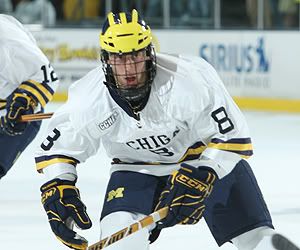 An exceptional all-around player, Palushaj has quick hands and an accurate shot, and is an first-rate passer and set-up man. His 34 assists last season for the Wolverines ranked him first on the team, and second in the nation. Palushaj added ten goals to those helpers, and his 44 total points ranked him third in the nation among freshmen. Those lofty accomplishments, however, couldn't get the Wolverines a championship, nor any significant individual honors for Palushaj, who managed only an honorable mention to the CCHA All-Rookie team.
An exceptional all-around player, Palushaj has quick hands and an accurate shot, and is an first-rate passer and set-up man. His 34 assists last season for the Wolverines ranked him first on the team, and second in the nation. Palushaj added ten goals to those helpers, and his 44 total points ranked him third in the nation among freshmen. Those lofty accomplishments, however, couldn't get the Wolverines a championship, nor any significant individual honors for Palushaj, who managed only an honorable mention to the CCHA All-Rookie team.
Last year, Palushaj played second fiddle to seniors Kevin Porter and Chad Kolarik, as well as fellow freshman Max Pacioretty. As a result, Palushaj didn't get the attention of the opposition's top checkers and was able to fly under the radar. This year, Palushaj's no secret to the opposition any more, and he's proving that last year's point totals weren't a result of facing second-unit checking lines.
Ian Cole (D, shoots L, 6'1, 211; Blues' 2nd pick, 18th overall, in 2007): A big, strong, mobile and mistake-free defenseman, Cole was drafted higher at 18th overall than any other Notre Dame player in history. An excellent skater, Cole has a powerful stride that facilitates rapid acceleration, and his recovery speed when getting back on defense is outstanding as well.
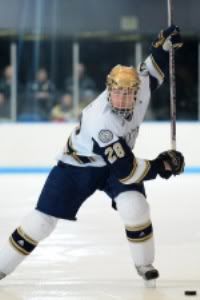 As a freshman last year with the Fighting Irish, Cole put up 8-12-20 totals in 43 games, his highest scoring totals in a single season since his midget days with Detroit Victory Honda. His modest scoring totals while with the US National Team Development Program have led to Cole's offensive game being somewhat under-rated, but last year's point totals -- as well as his 1-3-4 totals in just three games this year -- indicate that this aspect of his game is developing nicely. He makes a nice first pass out of the zone, and possesses solid offensive instincts that let him know when to join the rush and when to hold back.
As a freshman last year with the Fighting Irish, Cole put up 8-12-20 totals in 43 games, his highest scoring totals in a single season since his midget days with Detroit Victory Honda. His modest scoring totals while with the US National Team Development Program have led to Cole's offensive game being somewhat under-rated, but last year's point totals -- as well as his 1-3-4 totals in just three games this year -- indicate that this aspect of his game is developing nicely. He makes a nice first pass out of the zone, and possesses solid offensive instincts that let him know when to join the rush and when to hold back.
Cole's physical presence was what led the Blues to rank him as highly as they did, and he continues to play a rock-solid physical game at the next level. Strong as an ox, Cole also has the endurance to log big minutes, and can either muscle an opponent off the puck with ease or lay them out with a board-rattling check.
Nearly a generation ago (has it really been that long), the Blues had a big, physical defenseman who had a solid offensive game, was a rock on defense, and was a leader on and off the ice. Scott Stevens wasn't drafted or developed by the Blues, and only wore the 'Note for one season in his Hall of Fame career. While it's still too early to start mentioning Cole in the same breath with Stevens, the Blues and their fans have good reasons to hope that they can grow their own Stevens almost twenty years after losing the original.
Cade Fairchild (D, shoots L, 5'10, 186; Blues' 7th pick, 96th overall, in 2007): Not big or physical, Fairchild's game is all about offense. He stepped in as the QB of the Minnesota power play last year, and helped the Golden Gophers to a 13.0% conversion rate (25/193) with the man advantage.
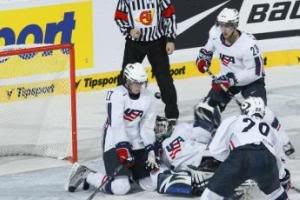 Fairchild can generate offense in the transition game with tape-to-tape breakout passes, and is able to make quick, no-look feeds even while on the move. These skills helped Fairchild to a 2-13-15 scoring line last year, but his minus-4 mark points to his issues in the defensive end.
Fairchild can generate offense in the transition game with tape-to-tape breakout passes, and is able to make quick, no-look feeds even while on the move. These skills helped Fairchild to a 2-13-15 scoring line last year, but his minus-4 mark points to his issues in the defensive end.
The McKeens Hockey Prospects website describes Fairchild as "a defensive liability that allows his man to get a step on him and go in clean to the net with scary regularity," and notes that his "lack of strength is most evident around his net, as he's easily out-muscled for position." To his credit, Fairchild has worked on those defensive shortcomings, and is currently a plus-2 for the Gophers. McKeens sums up Fairchild's potential by noting that he has "ability with the puck that you cannot teach, but he will need to bulk up and improve defensively to take the next step."
Jay Barriball (LW, shoots L, 5'9, 155; acquired in trade from San Jose, Feb. 27, 2007): Despite his lack of size, Barriball has a great big skill set, and is able to operate in traffic even at 5'9, 155. The Prior Lake, Minnesota native is now in his third year with the Golden Gophers, and is off to a decent start with one goal (a game-winner vs. St. Cloud State on Oct. 18) in two games.
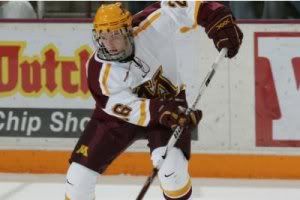 Entering this season, Barriball has 26 goals and 64 points in two seasons at the NCAA Division 1 level, and has had a couple of reasonably impressive showings at the Blues' Development Camp in 2007 and this year. Barriball is a decent skater with great puckhandling ability, and battles hard with and without the puck. He is also defensively aware, uses his speed to come back and help out in his own end, and his pucks skills allow him to create turnovers on defense.
Entering this season, Barriball has 26 goals and 64 points in two seasons at the NCAA Division 1 level, and has had a couple of reasonably impressive showings at the Blues' Development Camp in 2007 and this year. Barriball is a decent skater with great puckhandling ability, and battles hard with and without the puck. He is also defensively aware, uses his speed to come back and help out in his own end, and his pucks skills allow him to create turnovers on defense.
His size will always be a strike against him, but as long as there's a place for skill in the NHL, Barriball will have a shot.
Next time in "Tomorrow's Blues," we'll take a look at the rest of the Blues' college prospects, and see where all the prospects are after the first month of play. Until then, remember... "if we do not prepare for ourselves the role of the hammer, there will be nothing left but that of the anvil." Auf wiedersehen.
(This article was originally featured in "St. Louis Game Time," Vol. 4 No. 5, October 24, 2008 in "Tomorrow's Blues with Brian Weidler")The Blues are currently ranked the number one developmental organization in the NHL by the staff of the Hockey's Future website, in large part on the strength of their defense prospects. Three of the six players chosen by the Blues in the first round of the NHL Entry Draft over the last three seasons have been defensemen, and in those drafts the Blues have chosen a total of seven defensemen with picks in the top 100 each year.
Of course, a huge chunk of the Blues' future on defense is currently on the shelf, with first-rounders Erik Johnson (golf cart knee) and Alex Pietrangelo (cheap shot from Ryan Hollweg) on the injured list, and 2006 second-rounder Jonas Junland just about to return from a pre-season injury.
The loss of these players' services has resulted in players remaining in St. Louis this year -- Roman Pola'k, Steve Wagner, Jeff Woywitka and veteran Mike Weaver -- who would likely have otherwise been assigned to Peoria. Woywitka has since been sent down, and will play tonight for the Rivermen, but his presence in St. Louis has been a contributing factor to Peoria GM and Blues' Pro Scouting Director Kevin McDonald having to scrounge up defensemen on AHL contracts and pro tryouts in order to fill gaps in the lineup.
None of the three Blues-contracted defensemen currently in Peoria have scored a goal yet, and none have more than a single assist. All, however, bring something a little different to the table in terms of their experience and their style of play.
The youngest of this trio is rookie T.J. Fast, a former second-round pick of the L.A. Kings in 2005. Acquired by the Blues this summer in exchange for a fifth-round pick in the 2009 Entry Draft, the 6'2, 190-pound Fast is what his name implies, described by the McKeens Hockey Prospects website as "an agile and compact skater." The Calgary native left the University of Denver midway through his sophomore season in 2006-07 and landed with the Tri-City Americans of the WHL, where he blossomed into an offensive force at that level with 20 goals and 76 points in 97 career games.
Fast has been a healthy scratch for Peoria in several games thus far, largely due to some issues in the defensive end of the rink. McKeens correspondent Max Geise described him earlier this month as "a train-wreck defensively that runs around and chases after the puck while getting trapped up-ice and out of position routinely." Fast has a lot of skill, however, and will be given every chance to make the transition from the major junior game to the AHL.
Second-year man Alexander Hellström had a promising rookie season last year with Peoria, where the big (6'2, 207) Swede managed more goals (3) as a North American rookie than he scored in three seasons with IF Björklöven of the Allsvenskan from 2204-05 to 2006-07. Injuries limited Hellström's season to just 35 games, however, so the big southpaw is looking to stay healthy and continue his progress this year.
 McKeens describes Hellström as a "stay-at-home defenseman with a blossoming game in his own end." Strong as an ox, Hellström establishes himself in front of his net and is effective at keeping that area clear for his goalie. He's also a pretty good penalty killer, makes a good first pass, and is a very good shot blocker. All in all, as McKeens notes, Hellström is "a much more polished defender (this year) compared to last year."
McKeens describes Hellström as a "stay-at-home defenseman with a blossoming game in his own end." Strong as an ox, Hellström establishes himself in front of his net and is effective at keeping that area clear for his goalie. He's also a pretty good penalty killer, makes a good first pass, and is a very good shot blocker. All in all, as McKeens notes, Hellström is "a much more polished defender (this year) compared to last year."
The last of the Blues-contracted players in Peoria is veteran Andy Wozniewski. Signed as a free agent by the Blues this summer, the 28-year-old journeyman provides NHL-caliber depth for emergencies, and solid veteran leadership on Peoria's blueline. Wozniewski has great size at 6'5, 225 pounds, but he has yet to learn how to use that size effectively enough to keep a job in the NHL, and has also been plagued by injuries in his pro career.
Of course, the last line of defense is the goaltender, and the Blues' organization is pretty deep in that area as well. The two men who will stand between the pipes for the Rivermen this year are a study in contrasts.
Third-year pro Marek Schwarz has been consistently inconsistent during his time in Peoria. His record in three seasons is just above .500 at 33-28-2, and his goals-against average has been around the 2.77 mark in both of the previous seasons, though it currently stands at 5.17 thanks to a less-than-stellar outing against the Iowa Chops in the season opener on Oct. 10.
Schwarz is as athletic as they come in goal, and is in and out of the splits, and up and down in the butterfly, with lightning speed. The major issue with Schwarz has been a tendency to over-commit and be caught moving the wrong way; he is usually able to recover and make the save, but is then vulnerable to the rebound he leaves in doing so. There has been some concern about his mental toughness as well, but to his credit, Schwarz has enlisted the services of a sports psychologist in an attempt to address those issues.
Chosen 17th overall by the Blues in 2004, Schwarz is only the third goalie ever chosen by the Blues in the first round, and the first since John Davidson in 1973. The Blues still have high hopes for Schwarz, but this year could well be said to be a make-or-break season for him in the organization.
Schwarz will get plenty of chances to strut his stuff in the next few weeks, as fellow prospect Ben Bishop has been recalled to the Blues while Chris Mason recovers from an emergency appendectomy. Bishop, who can block out the sun at 6'7, 205 pounds, literally gives opponents nothing to shoot at when he is out of his net and challenging the shooter, and has the athleticism to recover quickly from the butterfly back to a standing position.
 Mentally tough, composed and confident, Bishop is adept at showing opponents a five-hole that looks like the Arch from the blueline, and then closing it up in the blink of an eye. Further, Bishop is also an outstanding puckhandler and offensive catalyst from his crease, often taking advantage of opposition line changes to fire breakout passes to his teammates.
Mentally tough, composed and confident, Bishop is adept at showing opponents a five-hole that looks like the Arch from the blueline, and then closing it up in the blink of an eye. Further, Bishop is also an outstanding puckhandler and offensive catalyst from his crease, often taking advantage of opposition line changes to fire breakout passes to his teammates.
Bishop appeared in five games for the Rivermen last season after completing an outstanding four-year career at the University of Maine, and has already been the subject of some AHL Rookie of the Year speculation. There are still areas of his game that need work -- rebound control and lateral quickness, for example -- but the sky is the limit for Bishop at this point.
Next time in "Tomorrow's Blues," a look at some of the Blues' top NCAA college prospects. Until then, remember... "if we do not prepare for ourselves the role of the hammer, there will be nothing left but that of the anvil." Auf wiedersehen.
 A former captain and scoring leader at one of the most prestigious prep programs in the Boston area (Belmont Hill), McCollem's career at Harvard did not get off to a great start last year (0 G, 3 A, minus-7 in his first 18 games). Once February rolled around, however, McCollem heated up as fast as the weather outside cooled down.
A former captain and scoring leader at one of the most prestigious prep programs in the Boston area (Belmont Hill), McCollem's career at Harvard did not get off to a great start last year (0 G, 3 A, minus-7 in his first 18 games). Once February rolled around, however, McCollem heated up as fast as the weather outside cooled down. This year, Sackrison has been playing on a line with Irwin and Jason Wiley, and Sackrison assisted on goals by both Wiley and Irwin as the Mavericks split a series with North Dakota last weekend.
This year, Sackrison has been playing on a line with Irwin and Jason Wiley, and Sackrison assisted on goals by both Wiley and Irwin as the Mavericks split a series with North Dakota last weekend. McKeens notes that Nill was "not expected to provide a lot of offense in the early going (at MSU this year), however (he) provides welcome size down the middle and plays a mature game on the defensive side of the puck." His defensive skills include an ability to tie up his man when taking faceoffs, and a regular shift on the penalty kill.
McKeens notes that Nill was "not expected to provide a lot of offense in the early going (at MSU this year), however (he) provides welcome size down the middle and plays a mature game on the defensive side of the puck." His defensive skills include an ability to tie up his man when taking faceoffs, and a regular shift on the penalty kill. At 6'4, 205, Erstad has the size and the skill set to make an impact no matter what level he plays, but there's some question about the heart, and the willingness to pay the price for a high-level career
At 6'4, 205, Erstad has the size and the skill set to make an impact no matter what level he plays, but there's some question about the heart, and the willingness to pay the price for a high-level career An exceptional all-around player, Palushaj has quick hands and an accurate shot, and is an first-rate passer and set-up man. His 34 assists last season for the Wolverines ranked him first on the team, and second in the nation. Palushaj added ten goals to those helpers, and his 44 total points ranked him third in the nation among freshmen. Those lofty accomplishments, however, couldn't get the Wolverines a championship, nor any significant individual honors for Palushaj, who managed only an honorable mention to the CCHA All-Rookie team.
An exceptional all-around player, Palushaj has quick hands and an accurate shot, and is an first-rate passer and set-up man. His 34 assists last season for the Wolverines ranked him first on the team, and second in the nation. Palushaj added ten goals to those helpers, and his 44 total points ranked him third in the nation among freshmen. Those lofty accomplishments, however, couldn't get the Wolverines a championship, nor any significant individual honors for Palushaj, who managed only an honorable mention to the CCHA All-Rookie team. As a freshman last year with the Fighting Irish, Cole put up 8-12-20 totals in 43 games, his highest scoring totals in a single season since his midget days with Detroit Victory Honda. His modest scoring totals while with the US National Team Development Program have led to Cole's offensive game being somewhat under-rated, but last year's point totals -- as well as his 1-3-4 totals in just three games this year -- indicate that this aspect of his game is developing nicely. He makes a nice first pass out of the zone, and possesses solid offensive instincts that let him know when to join the rush and when to hold back.
As a freshman last year with the Fighting Irish, Cole put up 8-12-20 totals in 43 games, his highest scoring totals in a single season since his midget days with Detroit Victory Honda. His modest scoring totals while with the US National Team Development Program have led to Cole's offensive game being somewhat under-rated, but last year's point totals -- as well as his 1-3-4 totals in just three games this year -- indicate that this aspect of his game is developing nicely. He makes a nice first pass out of the zone, and possesses solid offensive instincts that let him know when to join the rush and when to hold back. Fairchild can generate offense in the transition game with tape-to-tape breakout passes, and is able to make quick, no-look feeds even while on the move. These skills helped Fairchild to a 2-13-15 scoring line last year, but his minus-4 mark points to his issues in the defensive end.
Fairchild can generate offense in the transition game with tape-to-tape breakout passes, and is able to make quick, no-look feeds even while on the move. These skills helped Fairchild to a 2-13-15 scoring line last year, but his minus-4 mark points to his issues in the defensive end. Entering this season, Barriball has 26 goals and 64 points in two seasons at the NCAA Division 1 level, and has had a couple of reasonably impressive showings at the Blues' Development Camp in 2007 and this year. Barriball is a decent skater with great puckhandling ability, and battles hard with and without the puck. He is also defensively aware, uses his speed to come back and help out in his own end, and his pucks skills allow him to create turnovers on defense.
Entering this season, Barriball has 26 goals and 64 points in two seasons at the NCAA Division 1 level, and has had a couple of reasonably impressive showings at the Blues' Development Camp in 2007 and this year. Barriball is a decent skater with great puckhandling ability, and battles hard with and without the puck. He is also defensively aware, uses his speed to come back and help out in his own end, and his pucks skills allow him to create turnovers on defense. McKeens describes Hellström as a "stay-at-home defenseman with a blossoming game in his own end." Strong as an ox, Hellström establishes himself in front of his net and is effective at keeping that area clear for his goalie. He's also a pretty good penalty killer, makes a good first pass, and is a very good shot blocker. All in all, as McKeens notes, Hellström is "a much more polished defender (this year) compared to last year."
McKeens describes Hellström as a "stay-at-home defenseman with a blossoming game in his own end." Strong as an ox, Hellström establishes himself in front of his net and is effective at keeping that area clear for his goalie. He's also a pretty good penalty killer, makes a good first pass, and is a very good shot blocker. All in all, as McKeens notes, Hellström is "a much more polished defender (this year) compared to last year." Mentally tough, composed and confident, Bishop is adept at showing opponents a five-hole that looks like the Arch from the blueline, and then closing it up in the blink of an eye. Further, Bishop is also an outstanding puckhandler and offensive catalyst from his crease, often taking advantage of opposition line changes to fire breakout passes to his teammates.
Mentally tough, composed and confident, Bishop is adept at showing opponents a five-hole that looks like the Arch from the blueline, and then closing it up in the blink of an eye. Further, Bishop is also an outstanding puckhandler and offensive catalyst from his crease, often taking advantage of opposition line changes to fire breakout passes to his teammates.
